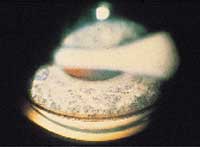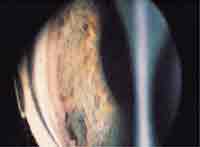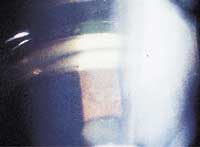Gonioscopy: how its results affect your glaucoma management decisions
As optometrists become more involved in the care of individuals with glaucoma, gonioscopy takes on an increasingly important role. Gonioscopy allows the visualization of the anterior chamber angle and is performed with a goniolens and slit lamp. Viewing and analyzing the anatomic relationships and structures within the anterior segment and angle allows the clinician to determine the form of glaucoma present. This classification is important because therapeutic and management decisions may hinge on it.
Many optometrists perceive gonioscopy to be difficult to perform and shy away from performing it routinely. It is a learned skill that requires a great deal of experience. While there is a learning curve, with perseverance it can be mastered. Over time, the practitioner will learn to stabilize the gonioscopic image by making micro adjustments as the procedure is being performed. Proper technique is important, as undue pressure may open a narrow angle, giving a false clinical impression. Many eyes need to be observed to understand the subtle differences between the normal and abnormal angle.
Gonioscopy’s purpose
 --- Pigmentary glaucoma, inferior angle: Note the fine pigment present within the trabecular meshwork. This form of glaucoma tends to occur in younger individuals and is associated with wide swings in IOP.
--- Pigmentary glaucoma, inferior angle: Note the fine pigment present within the trabecular meshwork. This form of glaucoma tends to occur in younger individuals and is associated with wide swings in IOP.
The purpose of gonioscopy goes beyond simply observing if the angle is open or narrow or if the eye can be dilated safely. Rather, there are different mechanisms that affect the outflow channels and anterior chamber angle and can affect the intraocular pressure (IOP). These mechanisms include:
- neovascularization of the anterior chamber angle,
- the development of anterior synechia, inflammation of the anterior segment with anterior or posterior synechia developing,
- pseudoexfoliative material occurring in the anterior segment and angle,
- pigment dispersion syndrome, slow closure of the angle (chronic angle closure glaucoma) or
- trauma with an angle recession present.
Other mechanisms within the anterior chamber that may lead to elevated IOP may be related to intraocular tumors or lens subluxation. Each of the glaucomas associated with a particular mechanism is different and requires a specific form of therapy and management. Some optometrists may skip gonioscopy when examining individuals suspected of developing glaucoma (based on optic nerve damage or visual field loss) if the angle is open after performing the van Herick angle estimation test.
Some may assume that the angle is wide open, so little additional information will be gained with gonioscopy. Gonioscopy should still be performed to look for a specific mechanism — such as excess pigment in the angle, new blood vessels within the angle or iris or a narrow angle — or to observe signs of trauma that may cause the IOP to elevate. At the end of the gonioscopic examination, the clinician should recognize if the glaucoma is of the garden-variety open-angle form (nothing unusual noted with gonioscopy) or if another, specific form of glaucoma is present.
Eye changes over time
 --- Angle recession, temporal angle: This patient was hit in the eye several years before this exam. The entire circumference of the angle is recessed and glaucoma has developed with elevated IOP that has been difficult to control. Note the different colors visible within the ciliary band region associated with the different layers of the ciliary muscle.
--- Angle recession, temporal angle: This patient was hit in the eye several years before this exam. The entire circumference of the angle is recessed and glaucoma has developed with elevated IOP that has been difficult to control. Note the different colors visible within the ciliary band region associated with the different layers of the ciliary muscle.
Gonioscopy must be performed periodically in individuals with glaucoma because the eye may change over time and new mechanisms may develop. One example of this is the individual who is diagnosed with pseudoexfoliative glaucoma with an open angle. With therapy, the condition is well controlled over several years. The IOP then starts to rise, and when gonioscopy is performed, the angle appears narrower than previously documented. A secondary narrow angle component (discovered with gonioscopy) has developed and it requires additional management.
Gonioscopy should thus be performed at the time of diagnosis and yearly thereafter for individuals being managed for glaucoma. Finally, gonioscopy should also be performed, no matter how recently it was last done, if a problem arises with the control of the IOP.
Different forms, different treatments
 --- Pseudoexfoliative glaucoma: Note the coarse pigment within the trabecular meshwork. Material that develops on the lens tends to be coarse, rubbing off pieces of iris pigment that then lodge within the trabecular meshwork. Similar to pigmentary glaucoma, wide swings in IOP often occur and may be difficult to control.
--- Pseudoexfoliative glaucoma: Note the coarse pigment within the trabecular meshwork. Material that develops on the lens tends to be coarse, rubbing off pieces of iris pigment that then lodge within the trabecular meshwork. Similar to pigmentary glaucoma, wide swings in IOP often occur and may be difficult to control.
Different forms of glaucoma have different courses and may respond better to one form of therapy or another. Pigmentary dispersion syndrome and pigmentary glaucoma, in which the trabecular meshwork is filled with a fine, granular pigmentation, are associated with wide swings in the IOP. While most medications work well, the condition can be difficult to control over time, and argon laser trabeculoplasty is often a useful therapeutic option.
Pseudoexfoliative glaucoma has coarse pigment as well as white, dandruff-like pseudoexfoliative material within the anterior chamber angle. The IOP tends to also be quite labile and difficult to control. Management is difficult, and the angle may also narrow over time — probably due to the zonules becoming damaged — allowing the lens to move forward.
In angle-recession glaucoma, in which a quadrant is dramatically wide open, the outflow pathways are damaged, reducing the efficacy of medications (miotics) or procedures (argon laser trabeculoplasty) that improve trabecular meshwork outflow. Therapy for angle-recession glaucoma tends to concentrate on reducing aqueous inflow.
Chronic angle-closure glaucoma has a clinical picture similar to open-angle glaucoma, with characteristic optic nerve and visual field damage. The exception is that there are no structures visible upon gonioscopy. In this situation, the angle closes slowly, rather than acutely and dramatically. Thus, the IOP rise occurs over time. Chronic angle-closure glaucoma is treated similarly to open-angle glaucoma, primarily with medications that reduce aqueous inflow.
Two types of gonioscopy
There are two different types of gonioscopy, with the indirect form most commonly performed. In the indirect form, the angle is viewed through a mirror housed within the gonioscopy lens. The angle viewed is 180° opposite to the placement of the mirror. Thus, a mirror placed temporally will allow a view of the nasal angle. There are also different types of gonioscopy lenses, with the Goldmann style three-mirror and Zeiss type four-mirror lenses as the most commonly used.
The Goldmann lens has multiple uses because there are different mirrors housed within the lens. It can be used to view the macula, peripheral retina or anterior chamber angle depending upon which lens is selected. The disadvantage with this lens is that it must be rotated to view each quadrant of the eye. Another disadvantage has been that the Goldmann or three-mirror style lenses require that a coupling solution, such as gonio gel, be used. These viscous solutions often irritate the cornea and must be irrigated after the procedure is completed.
Recently, three-mirror lenses that do not require a coupling solution have been introduced. Four-mirror lenses have the same mirror placed in each quadrant. These lenses do not require a coupling solution nor do they require the lens to be rotated as the procedure is performed. This allows four-mirror gonioscopy to be the most efficient type. If gonio solutions are used, any high viscosity tear, such as Celluvisc (carboxymethylcellulose sodium 1%, Allergan) works well with little irritation to the eye after the lens is removed.
Still, there is a significant learning curve for gonioscopy in general, and the four-mirror is the most difficult of the gonio procedures to master because suction does not develop. Rather, the touch of the clinician keeps the lens stabilized on the eye.
Gonioscopy should be part of the evaluation of any individual suspected of or having developed glaucoma. The information gained will allow the clinician to determine if a particular mechanism led to the IOP elevation and could influence both therapeutic and management decisions.
Glaucoma is not a static condition, and control at one point does not ensure control in the future. If the IOP does rise over time, gonioscopy should be repeated, with the clinician looking for any additional mechanism(s) that may have developed and could be related to the lack of IOP control.
While gonioscopy is often perceived as difficult and inefficient to perform, it is often one’s lack of familiarity that contributes to this discomfort. With experience, most clinicians become adept at the technique as well as its interpretation.
